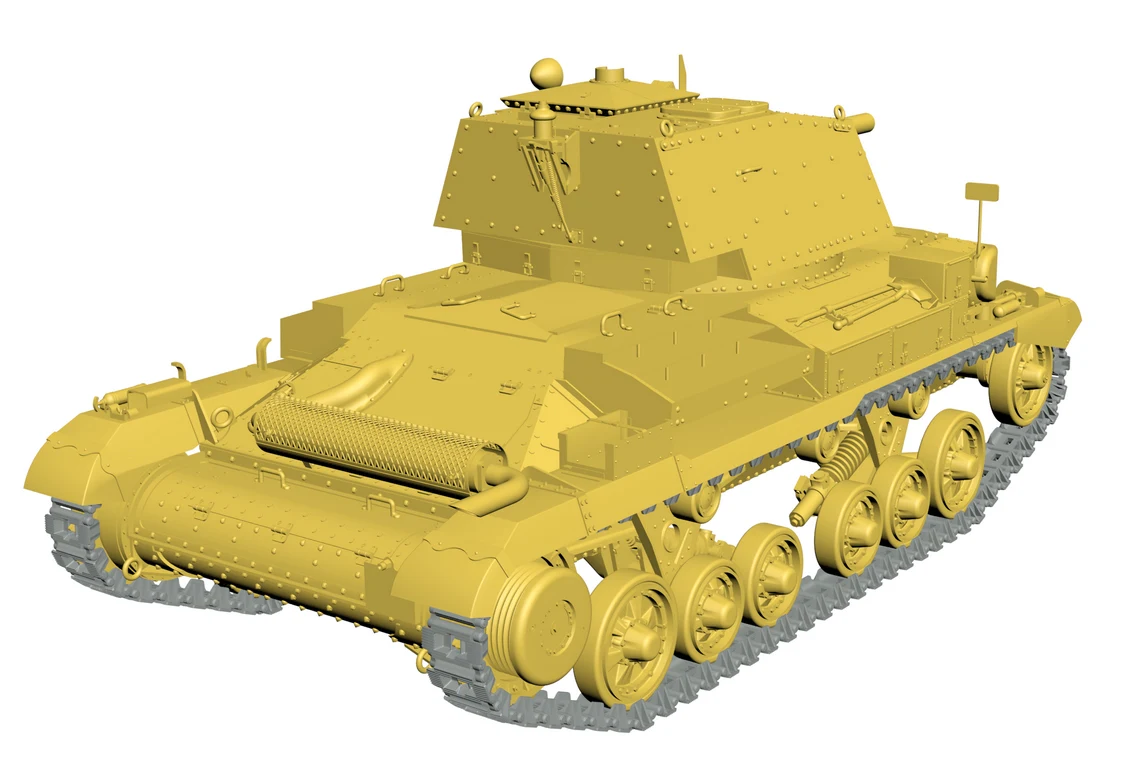Bronco's two new interesting kits, a new-tooled 35th scale cruiser Mk II in lots of different colours & sub-types, the other a 72nd scale DFS glider - this time with three rockets firing backwards in the nose. We have CAD pictures, colours and some info on the forthcoming kits in our preview...


Two new kits from Bronco Models on the way...
British Cruiser Tank Mk. II, IIA IIA CS
Nr. CB35150
1:35th scale
New tooled kit
Plastic injection parts including transparent parts
Photo etch parts included

To meet the requirement of modern tank concepts, in 1936, the British War Office designated two different categories of tanks for future development. The first category is a fast mobile cruiser tank designed not only to perform reconnaissance and patrol tasks, but also capable of making forays deep into enemy territory. The second Category is an armoured infantry tank designed to be used in close co-operation with infantry during attacks.
Tank Cruiser MK. I, code A9 was the first ever built cruiser tank in the United Kingdom. But while the A9 was still a prototype type in 1934, the British War Office had requested the production firm, the Vickers Armstrong Limited, to develop a more heavily armoured vehicle for better infantry support role.
On September 1937, a soft steel prototype Tank Cruiser MK. II, code A10 was produced. The armour thickness has been increased from 35/64 inch (14mm) in the A9 to 15/16 inch (24mm). To reduce weight, the two front single man machine guns turrets were removed. The increase in protection was achieved by bolting extra armour plate to the exterior of the hull and turret. This is the first practice of the application of additional steel plate design ever in British Tank.
Tank Cruiser MK. II according to their own weaponry can be sub-divided into three variants.
1. Tank Cruiser MK. II (A10 MK. I)
Equipped with a QF 2-pounder cannon and two 0.33-inch Vickers water-cooled machine guns.
2. Tank Cruiser MK. IIA (A10 MK. IA)
Equipped with a QF 2-pounder cannon and two BESA air-cooled machine gun.
3. Tank Cruiser MK. IIA CS (A10 MK. IA CS)
The CS (Close Support) version had a 3.7 inches (94 mm) howitzer in the turret assigned for infantry support role.
The production run A10 tank has a turret, engine and suspension identical to A9 version, but the thickness of bolt plates has been increased to 1 and 3/16 inch (30 mm) and the weight was increased to 14.3 tonnes. The maximum speed on road dropped to 16 mph, while off road as low as 8mph. As a result, the A10 tank was too slow to perform the envisioned cruiser tank duties like forays deep into enemy territory. The cruisers saw action in many of WWII's early battles, such as the battle of France, North African and Greek campaigns, the final production number was only 175 and phased out very quickly when a new type of cruiser tank enter into service.
The CAD drawings show us a lot more about this newly tooled kit
This variant of the cruiser is seen in many varied and interesting colour schemes we are sure modellers will like
DFS230V-6 Light Assault Glider W/ Deceleration rocket
GB7009
1/72nd scale
plastic injection moulded kit
Photo-etched parts included
plastic injection moulded kit
Photo-etched parts included
In 1936, the German military put forward the idea of the direct use of the glider to transport combat troops, putting forward the concept of "assault glider". In 1937 Deutsche Forschungsanstaltfür Segelflug, (DFS) successfully developed three prototypes from the military procurement volume (military project code DFS-230), that became the Luftwaffe standard light assault glider, the first type was the DFS-230A.
The glider utilised a high wing monoplane with a wing support hybrid structure, made from a rectangular fuselage use steel tube structure, covered with flax Bumonpi, which has a low cost and was easy and fast to produce. The machine could accommodate eight heavily armed soldiers and two pilots. It could be towed by a variety of Luftwaffe aircraft, and after take-off, the glider would drop its heavy landing gear and then later it would land on the centre line skid.For self-defence, the MG-15 was equipped with on DFS-230B to be used in the air and for self-defense and fire suppression on the ground.
To shorten the distance when landing the glider a series of tests were taken out in a modified DFS230A-1 with three retro rockets made by the Rheinmetall-Borsig company into the DFS230C-1 short take-off and landing type.

The test showed that the use of these three nose mounted rockets generated a reaction force that enabled the aircraft to a complete stop within 16 meters from touchdown to a full stop.
In addition, the smoke generated when the rocket fired also provided an effective "smoke screen" protection for the gliders and their paratroopers after landing. This system was used by the Germans in 1943 in the operation to rescue Mussolini action in Gran Sasso.
The CAD drawings of the kit - not the photo etched very thinly detailed parts...
The projected colour schemes of these gliders
Both of these kits should be out in about a month from Bronco's Distributors Worldwide.
Both of these kits should be out in about a month from Bronco's Distributors Worldwide.

























